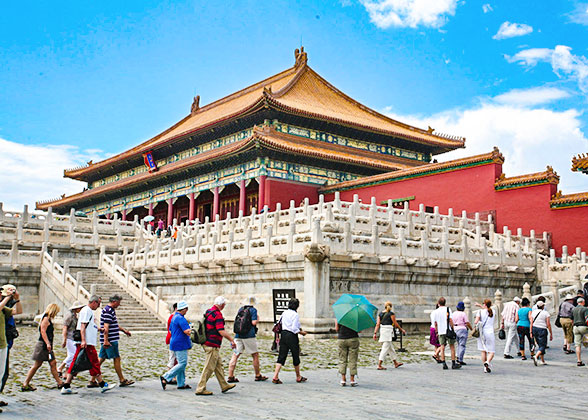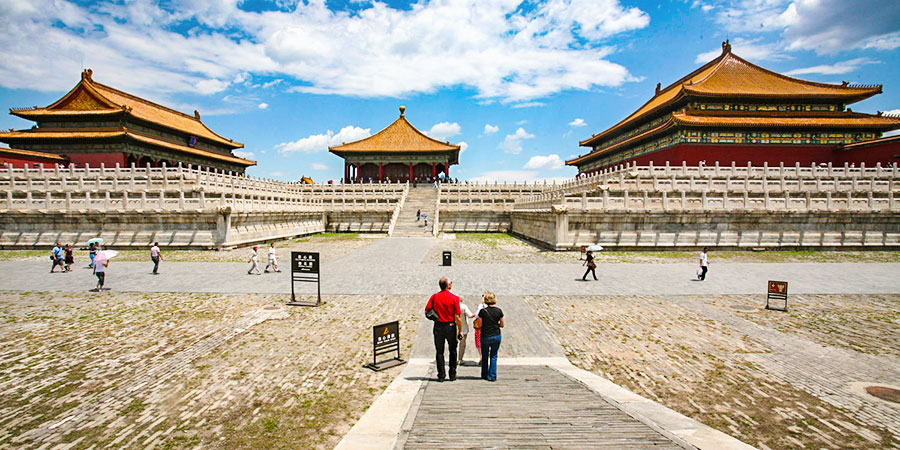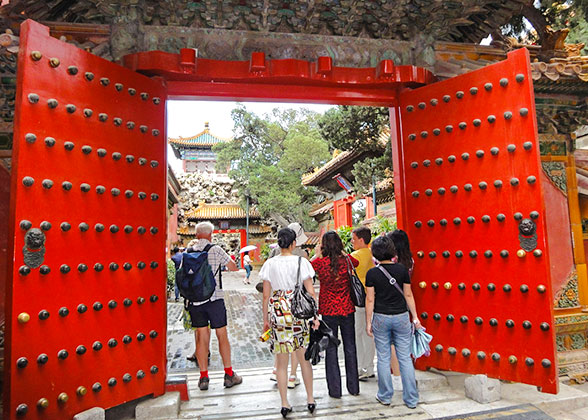8 Fun Facts about the Forbidden City
Basic Facts on the Forbidden City
Chinese Name: 故宫博物院/ 紫禁城
Chinese Pinyin: Gu Gong Bo Wu Yuan /Zi Jin Cheng
English Name: Palace Museum /Forbidden City
Location: in the center of Beijing
Previous Residents: 14 emperors from the Ming Dynasty (1368 - 1644), 10 emperors from the Qing Dynasty (1644 -1911), and their royal families.
Initiator: Emperor Chengzu of the Ming Dynasty
Designer: Kuai Xiang
Construction Period: 1406 to 1420 in the Ming Dynasty
 |
8 Interesting Facts about the Forbidden City
1. The Forbidden City is actually not forbidden now.
During the Ming and Qing dynasties, the Forbidden City was forbidden for commoners and only opened for imperial families and government officials who were invited. Now, it’s open for all as a tourist attraction.
![]() See more:Why is it called the Forbidden City?
See more:Why is it called the Forbidden City?
2. The Forbidden City has been dwelled by imperial families until 1924.
It was the home for emperors and their families since its establishment. When Puyi, the last emperor in China’s history was expelled from the Forbidden City in 1924 after his abdication, it was no longer the royal residence.
3. Yellow and red are the dominant colors in the Forbidden City.
The most prominent color scheme is represented by the red walls and yellow roof tiles. Yellow symbolizes earth elements at the center. The emperor assumes that the imperial palace is at the world's center and his reign radiates out from it. Hence, yellow is associated with the emperors' imperial dictum. Pillars, windows, doors and walls are mostly red which symbolizes auspicious events, happiness and celebrations, popular with the Chinese in daily usage.![]() See more:Forbidden City Architecture
See more:Forbidden City Architecture
4. The Forbidden City is divided into the Outer Court and Inner Court.
The Outer Court and Inner Court are architecturally different. Emperors had absolute godly power and held solemn public ceremonies in the Outer Court. The buildings here look solemn and grand. In contrast with the Outer Court, the Inner Court was where emperors enjoyed domestic bliss and did mundane tasks. The architectural styles are less formal with gardens and courtyards. Apart from the halls and palaces along the central axis, there are buildings on the two sides to accommodate lesser nobles.![]() See more:Layout of Forbidden City - Outer Court and Inner Court in Perfect Axisymmetry
See more:Layout of Forbidden City - Outer Court and Inner Court in Perfect Axisymmetry
5. There are no trees in the Outer Court.
 |
| The Grand Outer Court |
The Hall of Supreme Harmony, the Hall of Central Harmony, and the Hall of Preserved Harmony in the Outer Court are the prime structures for holding important rites and events. To show the imperial dignity and supreme authority, it was forbidden to plant trees around these halls. In fact, it was not permitted to plant trees along the imperial pavement from the Tiananmen Gate to the Meridian Gate either. All the trees you see today are from a more recent era. None has passed down from the times of monarchy.
6. Many gates are decorated with 9 rows of doornails.
 |
| Doornails Counted by 9 |
Many gates inside the imperial city, especially the huge red gates of the major structures, are decorated with gilded doornails. If you study them carefully, you will find that most of the gates have nine rows of doornails and each row consists of nine. Why? That's because nine implied supremacy in monarchist China and reserved for the emperor's use.
7. It's said that there are 9,999.5 rooms in the Forbidden City.
How Many Rooms are there in the Forbidden City? It is said that there are totally 9,999 and a half rooms in the Forbidden City because only the God of Heaven could be entitled to 10,000 rooms. Emperor Chengzu, who built the Forbidden City, declared himself the son of the God of Heaven, thus defining the smaller size of his palace. Therefore, it had half a room less when it was built. However in ancient Chinese architecture, one room refers to a square space among four pillars in a hall and it is impossible to have a half room among four pillars. By the latest count, there are 9,371 rooms, including big and small palaces, halls, towers, pavilions, belvederes. The 9,999 rooms and a half is just a myth.
![]() See more:How big is the Forbidden City?
See more:How big is the Forbidden City?
8. Ranks that the Forbidden City has gained:
![]() World Cultural Heritage Site: On the UNESCO World Heritage List in 1987.
World Cultural Heritage Site: On the UNESCO World Heritage List in 1987.
![]() Among the top 5 buildings in the world: The others are the Versailles Palace in France, the Buckingham Palace in Britain, the White House in America, and the Kremlin Palace in Russia.
Among the top 5 buildings in the world: The others are the Versailles Palace in France, the Buckingham Palace in Britain, the White House in America, and the Kremlin Palace in Russia.
![]() One of the most visited museums in the world: About 15 million visitors every year.
One of the most visited museums in the world: About 15 million visitors every year.
![]() Among the museums with the greatest variety of exhibitions in the world: It houses nearly 1 million cultural relics, including paintings, calligraphy, jade, embroidery, lacquer wares, pottery, etc.
Among the museums with the greatest variety of exhibitions in the world: It houses nearly 1 million cultural relics, including paintings, calligraphy, jade, embroidery, lacquer wares, pottery, etc.
![]() Largest and best-preserved palace complex in the world: Measuring 753 meters (823 yards) from east to west, and 961 meters (1,051 yards) from north to south, it covers an area of 72 hectares (178 acres) and the living quarters inside are well preserved.
Largest and best-preserved palace complex in the world: Measuring 753 meters (823 yards) from east to west, and 961 meters (1,051 yards) from north to south, it covers an area of 72 hectares (178 acres) and the living quarters inside are well preserved.
If you travel with your kids, you may tell them the interesting facts. It will be a lot of fun!
![]() Further Reading
Further Reading
History & FAQ of Forbidden City
What is the Forbidden City famous for?
Cycling in the Forbidden City - Recreation of the Last Emperor Puyi
